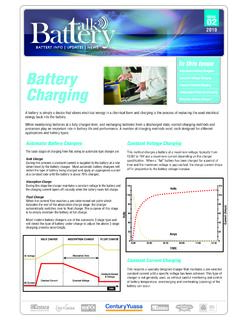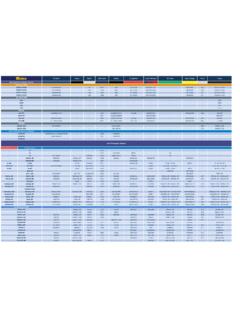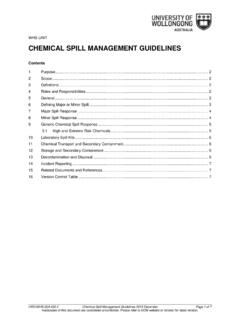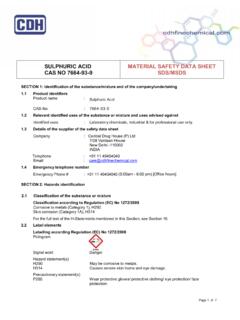Transcription of SAFETY DATA SHEET Document SDS-01898 LEAD ACID …
1 SAFETYDATASHEETLEADACIDBATTERY,WET,NON-S PILLABLED ocumentSDS-01898 Rev IDENTIFICATIONP roduct NameValve regulated lead acid (VRLA) batteryOther NamesElectric storage( sulphuric acid electrolyte), Lead acid battery , Wet, Non- spillable ,UseAutomotive,Industrial Standby Power and Motive Name andAddressCentury Yuasa Batteries37-65 Cobalt StCarole ParkQLD 4300 Telephone(07) 3361 6161 Emergency (24 Hours)(07) 3361 6707 Relevant identified usesStarting, lighting,ignition for car, truck, DC storage, forklift IDENTIFICATIONHAZARDOUS CHEMICAL. DANGEROUS to the Model WHS Regulations and the ADG ScheduleS6 Classified as S6:-Standard for the Uniform Schedulingof Medicines and Poisons (SUSMP)Signal WordDANGERGHS ClassificationMetal Corrosion Category 1, Acute Toxicity (Oral) Category 4, Acute Toxicity (Inhalation) Category 3, Skin Corrosion/IrritationCategory 1A, Serious Eye Damage Category 1,Carcinogen Category 1A, Reproductive Toxicity Category 1A, STOT-SE(Resp.)
2 Irr.) Category 3*, STOT-RE Category 2, Acute Aquatic Hazard Category 1, Chronic Aquatic Hazard Category 1*LIMITED EVIDENCEGHS LabelElementsCorrosiveAcutetoxicityHealt h HazardEnvironmentIN THE EVENT OF THE INTERNAL battery COMPONENTS BEING EXPOSEDH azard StatementsH290 May be corrosive to metalsH350 May cause cancerH302 Harmful if swallowedH360 May damage fertility or the unborn childH314 Causes severe skin burns and eyedamageH373 May cause damage to organs through prolonged orrepeated exposureH318 Causes serious eye damageH400 Very toxic to aquatic lifeH331 Toxic if inhaledH410 Very toxic to aquatic life with long lastingeffectsH335 May cause respiratory irritationIN THE EVENT OF EXPOSURE TO
3 INTERNAL COMPONENTSP recautionaryStatementsPreventionResponse P101If medical advice is needed, have productcontainer or label at +P312IF SWALLOWED:Call a POISON CENTER/doctor/physician/first aider/if you feel out of reach of childrenP301+P330+P331IF SWALLOWED: Rinse mouth. Do NOT release to the environmentP103 Read label before +P352IF ON SKIN: Wash with plenty of water and soapP280 Wear protective gloves/protectiveclothing/eye protection/face protectionP303+P361+P353IF ON SKIN (or hair): Take off immediately allcontaminated clothing. Rinse skin with not breathe dust/fume/gas/mist/ +P340IF INHALED: Remove person to fresh air and keepcomfortable for only outdoors or in a +P351+P338IF IN EYES: Rinse cautiously with waterfor severalminutes.
4 Remove contact lenses, if present and easyto do. Continue +P313IF exposed or concerned: Get medicaladvice/attentionP403+P233 Store in a well-ventilated container tightly call a POISON CENTER/doctor/physician/first aiderP405 Store locked upP333+P313If skin irritation or rash occurs: Get to section 13P342+P311If experiencing respiratory symptoms: Call a POISONCENTER/doctor/physician/first aiderDisposalP363 Wash contaminated clothing before of contents,container toauthorised chemical landfill or if organic,to high temperature incinerationP390 Absorb spillage to prevent ,WET,NON-SPILLABLED ocumentSDS-01898 Rev , INFORMATION ON INGREDIENTSI ngredientIdentificationContent % weightSulphuric acid <51%(H2SO4)CAS 7664-93-910-15%Lead (PbO)CAS 7439-92-130-40%LeadDioxide (PbO2)CAS1309-60-030-40%Inert material.
5 -ABS resinorPolypropyleneBorosilicate glass microfiberCAS 9003-56-9 CAS 9003-07-0 CAS 65997-17-35-8% AID MEASURESDESCRIPTION OF FIRST AID MEASURESEye contactIf this product comes in contact with the eyes: Immediately hold eyelids apart and flush the eye continuously with running water. Ensure complete irrigation of the eye by keeping eyelids apart and away from eye and moving the eyelids byoccasionally lifting the upper and lower lids. Continue flushinguntil advised to stop by the Poisons Information Centre or a doctor, or for at least 15 minutes. Transport to hospital or doctor without delay. Removal of contact lenses after an eye injury should only be undertaken by skilled contactIf skin contact occurs: Immediately flush body and clothes with large amounts of water, using SAFETY shower if available.
6 Quickly remove all contaminated clothing, including footwear. Wash skin and hair with running water. Continue flushing with water until advised to stop by the Poisons fumes of combustion products are inhaled: Lay patient down. Keep warm and rested. Prostheses such as false teeth, which may block airway, should be removed, where possible, priorto initiating first aidprocedures. Apply artificial respiration if not breathing, preferably with a demand valve resuscitator, bag-valve mask device, orpocket mask as trained. Perform CPR if necessary. Transport to hospital, or doctor, without advice, contact a Poisons Information Centre or a doctor at once.
7 Urgent hospital treatment is likely to be needed. If swallowed doNOTinduce vomiting. If vomiting occurs, lean patient forward or place on left side (head-downposition, if possible) to maintain open airwayand prevent aspiration. Observe the patient carefully. Never give liquid to a person showing signs of being sleepy or with reduced awareness; becoming unconscious. Give water to rinse out mouth, then provide liquid slowly and as much as casualty can comfortably drink. Transport to hospital or doctor without ATTENTION AND SPECIAL TREATMENTI ndication of any immediate medical attention and special treatment acute or short term repeated exposures to strong acids: Airway problems may arise from laryngeal edema and inhalation with 100% oxygen initially.
8 Respiratory distress may require cricothyroidotomy if endotrachealintubation is contraindicated by excessive swelling Intravenous lines should be established immediately in all cases where there is evidence of circulatory compromise. Strong acids produce a coagulation necrosis characterised by formation of a coagulum (eschar) as a result of thedesiccating action of the acid on proteins in specific : Immediate dilution (milk or water) within 30 minutes post ingestion is recommended. DO NOT attempt to neutralise the acid since exothermic reactionmay extend the corrosive injury. Be careful to avoid further vomit since re-exposure of the mucosa to the acid is harmful.
9 Limit fluids to one or two glasses in an adult. Charcoal has no place in acid management. Some authors suggest the use of lavage within 1 hour of : Skin lesions require copious saline irrigation. Treat chemical burns as thermal burns with non-adherent gauze and wrapping. Deep second-degree burns may benefit from topical : Eye injuriesrequire retraction of the eyelids to ensure thorough irrigation of the conjuctival cul-de-sacs. Irrigationshould last at least 20-30 minutes. DO NOT use neutralising agents or anyother additives. Several litres of saline arerequired. Cyclopaedic drops,(1% cyclopentolate for short-term use or 5% homatropine for longer term use) antibiotic drops,vasoconstrictive agents or artificial tears may be indicated dependent on theseverity of the injury.
10 Steroid eye drops should only be administered with the approval of a consulting ophthalmologist).SAFETYDATASHEETLEADACID battery ,WET,NON-SPILLABLED ocumentSDS-01898 Rev FIGHTING MEASURESR ecommendedExtinguishing MediaWater spray or chemical \Vaporising Liquid(Where regulations permit). Extinguishing MediaIncompatibilities Water may cause electrical hazard If terminals not Use extinguishing media suitable for surrounding HazardsHazardousDecomposition Non-combustible. Not considered to be a significantfire risk. Acids may react with metals to produce hydrogen, a highly flammable and explosive gas. Heating may cause expansion or decomposition leading to violent rupture of Incompatibility Avoid strong bases.





